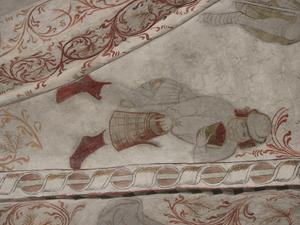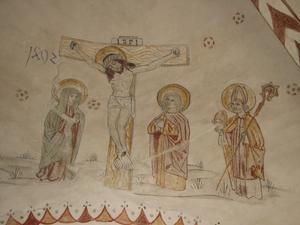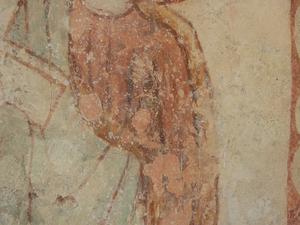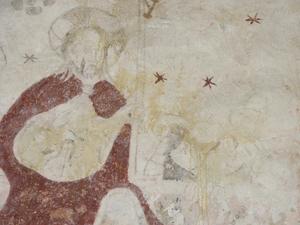About damages
The state of preservation of a wall painting is based on the presence of following types of damages: soiling, stains, micro-organic activity, salt damages, plaster damages, cracks, damages in paint layers and layers of lime wash and discolorations. It is often difficult to delineate types of damages, as they are interdependent. For example stains can lead to salt damages resulting in the flaking of paint layers and lime wash layers. Soiling attract microorganic activity. Cracks can attract dust and particles of sooth etc.
Most wall paintings had been covered by layers of limewash for centuries. But, whether the paintings had been covered up or exposed, the impression of the colours has changed since the day the painter finished his work. In most cases what we see today is another image compared to the flamboyance of the past. The change in colours due to the ravages of time is not included in the state of preservation and as such is not indicated as damage. For further information about the colours of wall paintings go to The colours of wall paintings.
Whether situated beneath or above the vaults, wall paintings are exposed to the same types of damages, although their degree and extent varies. The most common damages on wall paintings situated beneath the vaults are soiling and salt damages. The most common damages above the vaults are caused by blows or strikes. Furthermore severe soot damage from early heating systems is frequently seen above vaults.
As a rule, the wall paintings beneath the vaults have been restored many times, whereas paintings above the vaults rarely have been restored at all.
The current approach to conservation and restoration of wall paintings is to do only what is necessary, hence preserving as much of the original paintings possible. The nature of the actions to be taken naturally depends on the character, degree and extent of the damages.
All documentation pertaining to the conservation and restoration of wall paintings is held in the Antiquarian –Topographical Archive at the Danish National Museum in Copenhagen.
Damages by soiling
Damages by soiling occur when dust, particles of sooth and other particle pollution are deposited on the surfaces of wall paintings. Soiling increases when particles are transported by hot air to cold surfaces causing condensation. Consequently heating systems as well as candles contributes to soiling of wall paintings.
Soiling can be removed by using dry sponges or other dry cleaning methods, or by using wet cleaning with water. Especially particles of sooth are difficult to fully remove, and it is often necessary to use chemicals to eliminate sooth. Despite these often gentle methods, removal of soil are stressful to the wall paintings.
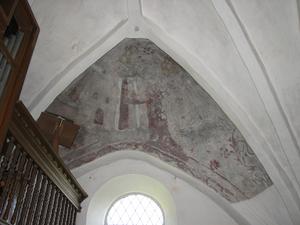


Stains
Stains occur when water penetrate into the masonry bringing impurities and occasionally salts to the surface. Penetrating water is often the consequence of leaking roofs or walls. Water in the masonry can also be the consequence of hot humid air, which condensates on cold surfaces. Stains appear usually as yellowish or brownish discolorations and are usually seen in vaults.
Discolorations after stains are difficult to remove and the solution are often to minimize them visually by retouching. Stains can be prevented by keeping roofs and walls sealed, furthermore by regulating the indoor climate of the church in order to prevent condensation on the surfaces.
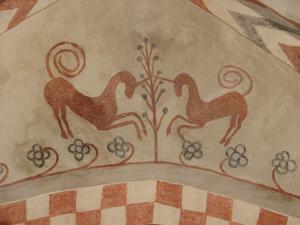
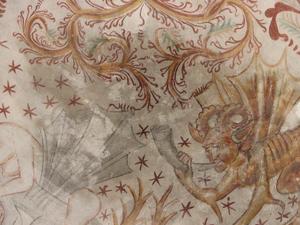


Micro-organic activity
Micro-organic activity is a consequence offavorable living conditions for micro-organisms, including certain climatic conditions and access to nourishment. The metabolism of microbes produces chemical substances which deteriorate wall paintings and causes discoloration. Micro-organic activity is often seen as spots or colonies of spots, the coloring of the spots varying according to which microorganisms are present.
A pink color indicates the presence of bacteria, a greyish color typically mold, a greenish color the presence of green alga and a black color either bacteria, mold or green alga.
Organic growth is removed by gentle brushing, dry cleaning or wet cleaning.

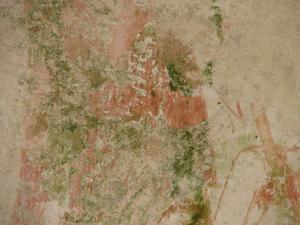

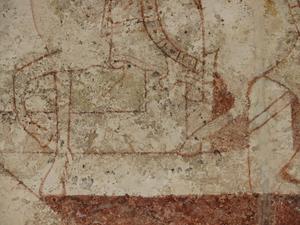

Plaster damage
Plaster damages include loss of material, degraded or weathered plaster surfaces or the plasters poor adherence to the substructure. Plaster damages occur due to stains, salt damages, cracks and mechanical damages including tool tracks, erosion from nails etc. Furthermore damages are often a consequence in repairs. Damages are often determined by the composition of the lime mortar, and how it is applied to the structure.
Plaster damages are repaired with a new lime mortar or by impregnation of the original lime mortars deteriorated surface.
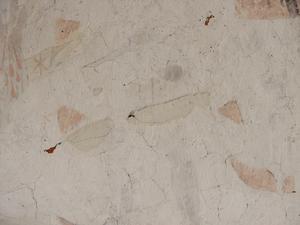
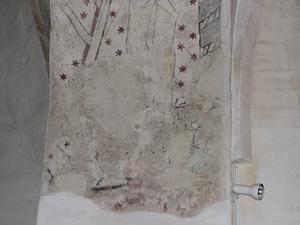
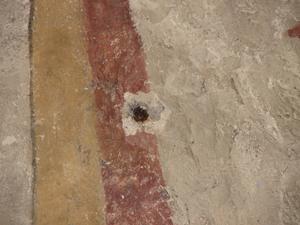

Salt damages
The biggest threat to the preservation of wall paintings is salt, typically chlorides, nitrates and sulfates. Salts are components of the building masonry or rises up into the masonry from the ground. Salt can also be brought from the sea by air. Finally salt derives from pollution or bird dung.
Salt damages occurs, when salt dissolved in water in the masonry, are transported unto the surface, where it crystalizes as the water evaporates. The crystallization can cause the paint layers, layers of lime wash or plaster layers to flake and eventually flake off. The presence of water in the masonry is a necessity for salt to be transported.
Crystallized salts appears on the surface of the masonry as points of rough bulges of single crystals, thick layers of white tiny crystals, partly transparent greyish layers, even hard areas of crystals integrated in the surface or cauliflower shaped formations of crystals.
Crystallized salt can sometimes be removed by gentle brushing the surface or by extracting the salt. Salt damages are a consequence of the presence of water in the masonry, whereas salt damages can be prevented by keeping roofs and walls in a good condition, furthermore by regulating the indoor climate of the church in order to prevent transportation and deposition of salt.

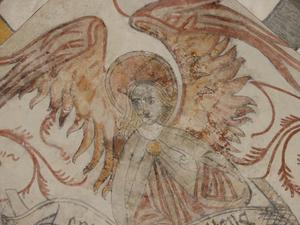

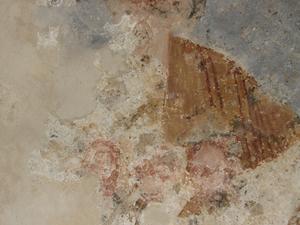
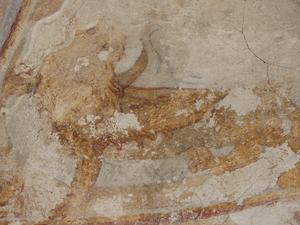
Cracks
Cracks are caused by movements in the masonry, the composition or hardening of lime mortar or a consequence of erosive objects inserted in the masonry.
Phrase cracks are often a consequence of movements in the church’s foundation which again escalates up into the masonry. Weakening of the church’s foundation is often a consequence of construction of drainage or changes in the water table. Phrase cracks are also a consequence of pressure from the roof construction or tension in the upper parts of the masonry of the church.
Shrinkage cracks are minor cracks in the surface and are a consequence of incorrect material composition of lime mortar, ie if the content of calcium is too high. Shrinkage cracks can also be a consequence of the lime mortar drying too quickly.
Cracks can also evolve due to erosion of inserted objects in the masonry, including wall anchors and nails of iron.
Deep cracks are usually repaired by carving out the cracks and filling the cracks with several layers of lime mortar. Minor cracks does not demand carving out the cracks, but are filled out with fine-grained lime mortar or slaked lime. Often minor crack can only be seen due to their ability to attract dust, and therefore “disappears” by merely cleaning the surface.
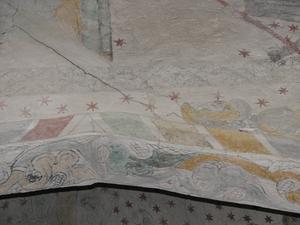

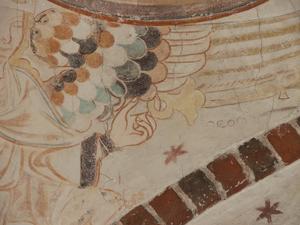
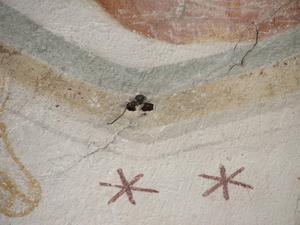


Damages in paint layers and layers of lime wash
Damages in paint layers and layers of lime wash are seen as flakes on the surface of the masonry, or as bare areas, where the layers has flaked off.
Damages in paint layers and lime wash layers are caused by soiling, stains, micro-organic activity, salts or crack. Furthermore mechanical damages due to damages from uncovering the wall paintings, lime washing, mounting of installations and furniture, wear and scratches etc. from physical contact and graffiti.
Damages in paint layers and layers of lime wash are divided into active and inactive damages. Active damages are ongoing and need conservation treatment to prevent the wall paintings from further deterioration. Inactive damages only have influence on the wall paintings visual expression and are restored due to aesthetic reasons.
Treatment of active damages demands consolidation of flaking layers of paint layers and layers of lime wash with lime based materials. Treatment of inactive damages requires restoration of the wall paintings visual expression. Damages in paint layers and layers of lime wash are treated with reversible materials and methods, which can be removed or retreated if necessary.
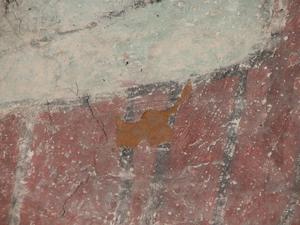


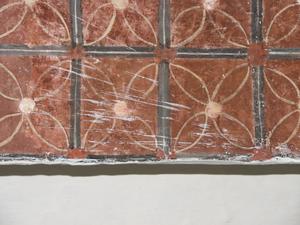
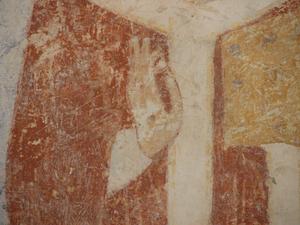
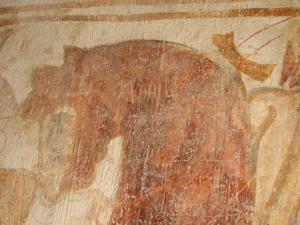
Discoloration
Discoloration comes from soiling, stains, micro-organic activity and salt. In addition the colors of restored paint layers, layers of lime wash and plaster layers can change over time, often darkening. Especially if incorrect methods and materials are used at the time of conservation and restoration.
In addition to removal of discoloration, action must be taken to eliminate their cause.
Discoloration due to sooth particles is difficult to remove, and often it is necessary to use chemicals. In the case of darkened repairs, the repairs are removed, whereupon the paint layers are re-retouched.

